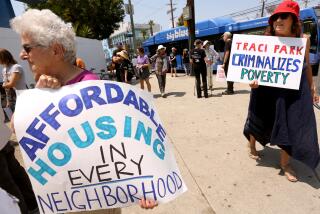Why CDC Report on Suburban Living Is Junk
- Share via
Re “Report Deals a Blow to Suburbs,” Jan. 7: I used the adjective “junk” in a very specific context when discussing with your reporter the Centers for Disease Control’s report on the supposed negative health effects of sprawl. The report theorizes that suburban living increases respiratory disease (because of poorer air quality) and heart disease and obesity (because of a lack of exercise opportunities). The authors work at an institution that provides access to volumes of data on respiratory disease, heart disease and obesity. All they had to do to create a convincing, scientifically sound argument was analyze this data and compare what it says about suburban versus urban living, yet there were no such comparisons in the study.
The complete lack of comparative health data leaves only two possible conclusions: The study is junk because the authors did no work to substantiate their thesis, or they saw the data, realized it undercut their argument and chose not to present it. In that case, junk is too kind a description.
Smog alerts in Southern California are down 75% since 1970, despite a tripling of our population--much of it going to the suburbs--during the same period. Crime rates and traffic congestion are both higher in urban areas, which would tend to discourage exercise in non-sprawl neighborhoods. Most new neighborhoods, on the other hand, offer parks, sidewalks and trails that encourage exercise. Reality, therefore, runs counter to the opinions stated in the CDC report, making the report’s lack of data all the more unfortunate.
The authors are correct in their belief that planners have a responsibility to consider human health in their community designs. Planners also have a responsibility to plan a community people will want to live in. In Southern California, we are addressing both, which is why in new planned communities one sees design being used to make towns more car-friendly, because people want to drive, and more health-friendly, because residents want to be able to walk, bike and run with safety in their neighborhoods.
Laer Pearce
Spokesman, Southern California
Building Industry Assn.
Laguna Hills






